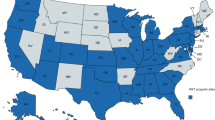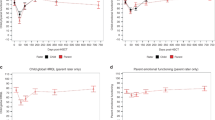Summary:
Although pediatric stem cell transplantation is associated with elevated risks for quality-of-life (QOL) deficits, morbidity, and late effects, little is known about how supportive care needs are addressed across different pediatric centers. This study examined practice patterns among centers enrolled in the Pediatric Blood and Marrow Transplant Consortium. In all, 65 centers (response rate=82.2%) were surveyed regarding QOL screening, psychosocial intervention services, and long-term follow-up care. Approximately 80% of centers provided routine screening for psychological difficulties and pain. A smaller number screened for fatigue (69.2%), cognitive deficits (52.3%), sleep difficulties (60.0%) or spiritual concerns (38.5%). Screening was conducted predominantly via interview; little use was made of standardized measures. Community-based centers screened some deficits more frequently than did academic ones (all P's⩽0.09). In all, 60% of centers provided support groups and 49.2% offered arts-in-medicine programs. Most centers provided extended follow-up care. In some, follow-up continued until age 21 (45.4%), while in others it was sustained indefinitely (40.6%). Findings suggest that QOL screening would be enhanced by greater attention to domains that currently receive limited scrutiny, and by increased use of validated measures to supplement interview information. The proportion of centers that provide extended follow-up is encouraging, and offers opportunities to study long-term outcomes.
This is a preview of subscription content, access via your institution
Access options
Subscribe to this journal
Receive 12 print issues and online access
$259.00 per year
only $21.58 per issue
Buy this article
- Purchase on Springer Link
- Instant access to full article PDF
Prices may be subject to local taxes which are calculated during checkout
Similar content being viewed by others
References
Mehta P . Pediatric Stem Cell Transplantation. Jones & Bartlett: Boston, 2004.
Phipps S, Barclay D . Psychosocial consequences of pediatric bone marrow transplantation. Int J Pediatr Hematol Oncol 1996; 3: 171–182.
Sherman AC, Simonton S, Latif U . Quality of life outcomes and psychosocial adjustment following pediatric stem cell transplantation. In: Mehta P (ed.). Pediatric Stem Cell Transplantation. Jones & Bartlett: Boston, 2004; pp 99–115.
Phipps S, Dunavant M, Garvie PA et al. Acute health-related quality of life in children undergoing stem cell transplant: I. Descriptive outcomes. Bone Marrow Transplant 2002; 29: 425–434.
Packman WL, Crittenden MR, Fischer J et al. Siblings' perceptions of the bone marrow transplantation process. J Psychosoc Oncol 1997; 15: 81–105.
Buchsel PC, Leum EW, Randolph SR . Delayed complications of bone marrow transplantation: an update. Oncol Nurs Forum 1996; 23: 1267–1291.
Ganz PA . Quality of life and the patient with cancer: individual and policy implications. Cancer 1994; 74: 1445–1452.
Cella DF, Tulsky DS . Methods and problems in measuring quality of life. Supportive Care Cancer 1995; 3: 11–22.
Barrera M, Pringle L-AB, Sumbler K, Saunders F . Quality of life and behavioral adjustment after pediatric bone marrow transplantation. Bone Marrow Transplant 2000; 26: 427–435.
Stuber ML, Nader K, Yasuda P et al. Stress responses after pediatric bone marrow transplantation: preliminary results of a prospective longitudinal study. J Am Acad Child Adolesc Psychiatry 1991; 30: 952–957.
Phipps S, Brenner M, Heslop H et al. Psychological effects of bone marrow transplantation on children and adolescents: preliminary report of a longitudinal study. Bone Marrow Transplant 1995; 15: 829–835.
Pot-Mees CC . The Psychosocial Effects of Bone Marrow Transplantation in Children. Eburon Publishers: Delft, 1989.
Arvidson J, Larsson B, Lonnerholm G . A long-term follow-up study of psychosocial functioning after autologous bone marrow transplantation in childhood. Psycho-Oncol 1999; 8: 123–134.
Felder-Puig R, Peters C, Matthes-Martin S et al. Psychosocial adjustment of pediatric patients after allogeneic stem cell transplantation. Bone Marrow Transplant 1999; 24: 75–80.
Vannatta K, Zeller M, Noll RB, Koontz K . Social functioning of children surviving bone marrow transplantation. J Pediatr Psychol 1998; 23: 169–178.
Badell I, Igual L, Gomez P et al. Quality of life in young adults having received a BMT during childhood: a GETMON study. Bone Marrow Transplant 1998; 21 (Suppl 2): S68–S71.
Schmidt GM, Niland JC, Forman SJ et al. Extended follow-up in 212 long-term allogeneic bone marrow transplant survivors: issues of quality of life. Transplantation 1993; 55: 551–557.
Phipps S, Dunavant M, Srivastava DK et al. Cognitive and academic functioning in survivors of pediatric bone marrow transplantation. J Clin Oncol 2000; 18: 1004–1011.
Kramer JH, Crittenden MR, DeSantes K, Cowan MJ . Cognitive and adaptive behavior 1 and 3 years following bone marrow transplantation. Bone Marrow Transplant 1997; 19: 607–613.
Coluzzi PH, Grant G, Doroshow JH et al. Survey of the provision of supportive care services at National Cancer Institute-designated cancer centers. J Clin Oncol 1995; 13: 756–764.
Tesauro GM, Rowland GH, Lustig C . Survivorship resources for post-treatment cancer survivors. Cancer Pract 2002; 10: 277–283.
Addington-Hall JM, Weir MW, Zollman C, McIllmurray MB . A national survey of the provision of support services for people with cancer. Br Med J 1993; 306: 1649–1650.
Recklitis C, O'Leary T, Diller L . Utility of routine psychological screening in the childhood cancer survivor clinic. J Clin Oncol 2003; 21: 787–792.
Sherman AC, Coleman EA, Griffith K et al. Use of a supportive care team for screening and preemptive intervention among multiple myeloma patients receiving stem cell transplantation. Support Care Cancer 2003; 11: 568–574.
Passik SD, Dugan W, McDonald MV et al. Oncologists' recognition of depression in their patients with cancer. J Clin Oncol 1998; 16: 1594–1600.
Zhukovsky DS, Gorowski E, Hausdorff J et al. Unmet analgesic needs in cancer patients. J Pain Symptom Manage 1995; 10: 113–119.
Gaston-Johansson F, Franco T, Zimmerman L . Pain and psychological distress in patients undergoing autologous bone marrow transplantation. Oncol Nurs Forum 1992; 19: 41–48.
Grossman SR, Benedetti C, Brooke C et al. NCCN practice guidelines for cancer pain. Oncology 2000; 14 (11A): 135–150.
Stjernsward J, Colleau SM, Ventafridda V . The World Health Organization Pain and Palliative Care Program. Past, present, and future. J Pain Symptom Manage 1996; 12: 65–72.
Hann DM, Jacobsen PB, Martin SC et al. Quality of life following bone marrow transplantation for breast cancer: a comparative study. Bone Marrow Transplant 1997; 19: 257–264.
Irvine D, Vincent L, Graydon J et al. The prevalence and correlates of fatigue in patients receiving chemotherapy and radiotherapy. Cancer Nurs 1994; 17: 367–378.
Ottery FD . Cancer cachexia: prevention, early diagnosis, and management. Cancer Pract 1994; 2: 123–131.
Yarrington A, Mehta P . Does sleep promote recovery after bone marrow transplantation? – a hypothesis. Pediatr Transplantation 1998; 2: 51–55.
Davidson JR, MacLean AW, Brundage MD, Schulze K . Sleep disturbance in cancer patients. Soc Sci Med 2002; 54: 1309–1321.
Katon W, Sullivan MD . Depression and chronic medical illness. J Clin Psychiatry 1994; 51: 8–19.
Ottery FD . Definition of standardized nutritional assessment and interventional pathways in oncology. Nutrition 1996; 12: S15–S19.
Perron V, Schonwetter RS . Assessment and management of pain in palliative care patients. Cancer Control 2001; 8: 15–24.
Holland J . NCCN practice guidelines for the management of psychosocial distress. Oncol 1999; 13: 113–147.
Atkinson A, Barsevick A, Cella D et al. NCCN practice guidelines for cancer-related fatigue. Oncol 2000; 14: 151–161.
Phipps S, Dunavant M, Jayawardene D, Srivastiva DK . Assessment of health-related quality of life in acute in-patient settings: use of the BASES instrument in children undergoing bone marrow transplantation. Intl J Cancer Suppl 1999; 12: 18–24.
Varni JW, Seid M, Kurtin PS . PedsQL 4.0: reliability and validity of the Pediatric Quality of Life Inventory Version 4.0. generic core scales in healthy and patient populations. Med Care 2001; 39: 800–812.
McCarthy AM, Cool VA, Petersen M, Bruene DA . Cognitive behavioral pain and anxiety interventions in pediatric oncology centers and bone marrow transplant units. J Pediatr Oncol Nurs 1996; 13: 3–12.
Mehta P, Fetting J . Can you cure him, for the baby's sake? J Clin Oncol 2003; 21: 4064–4065.
Linzer M, Visser MR, Oort FJ et al. Predicting and preventing physician burn-out: results from the United States and the Netherlands. Am J Med 2001; 111: 170–175.
Ramirez AJ, Graham J, Richards MA et al. Burnout and psychiatric disorders among cancer clinicians. Br J Cancer 1995; 71: 1263–1269.
Redman S, Turner J, Davis C . Improving supportive care for women with breast cancer in Australia: the challenge of modifying health systems. Psycho-Oncol 2003; 12: 521–531.
Author information
Authors and Affiliations
Corresponding author
Additional information
Based in part on data presented at the Mayo Clinic Quality of Life Conference, Scottsdale, AZ, October 2–4, 2003.
Rights and permissions
About this article
Cite this article
Sherman, A., Simonton, S., Latif, U. et al. Psychosocial supportive care for children receiving stem cell transplantation: practice patterns across centers. Bone Marrow Transplant 34, 169–174 (2004). https://doi.org/10.1038/sj.bmt.1704546
Received:
Accepted:
Published:
Issue Date:
DOI: https://doi.org/10.1038/sj.bmt.1704546
Keywords
This article is cited by
-
Psychological effects of hematopoietic SCT on pediatric patients, siblings and parents: a review
Bone Marrow Transplantation (2010)



